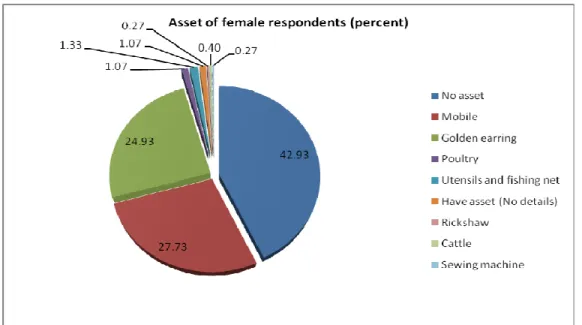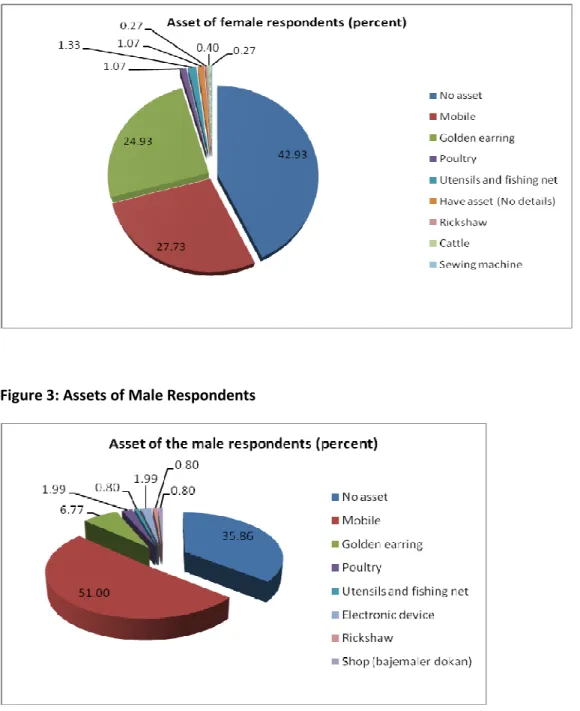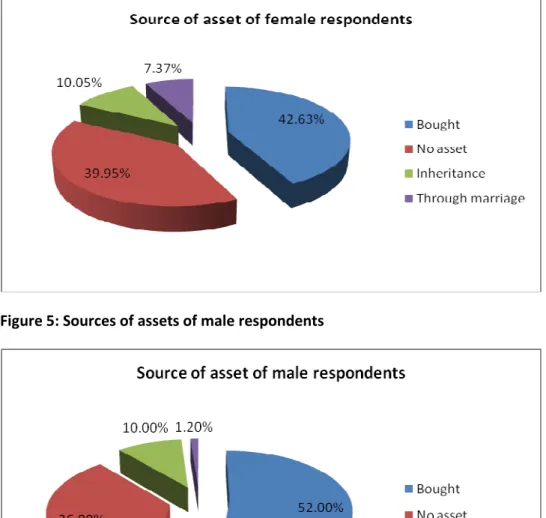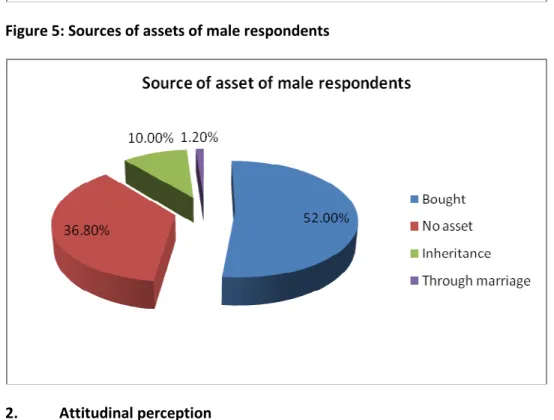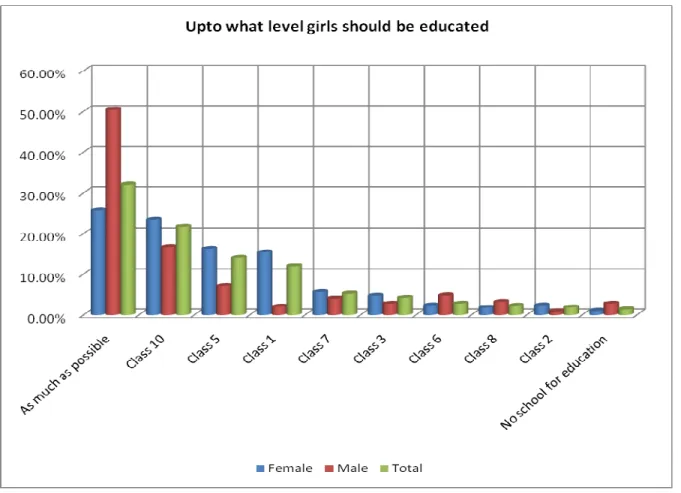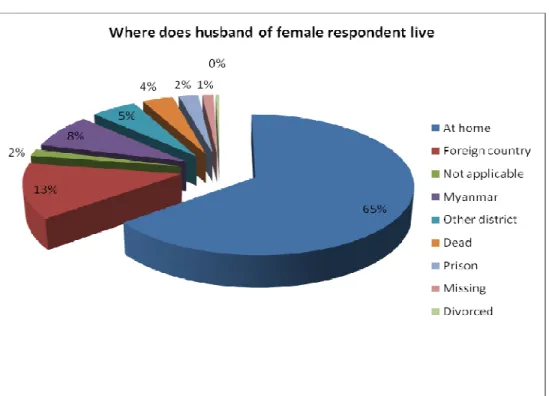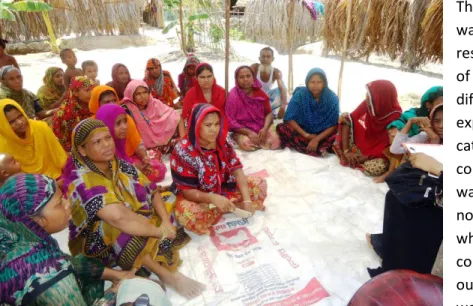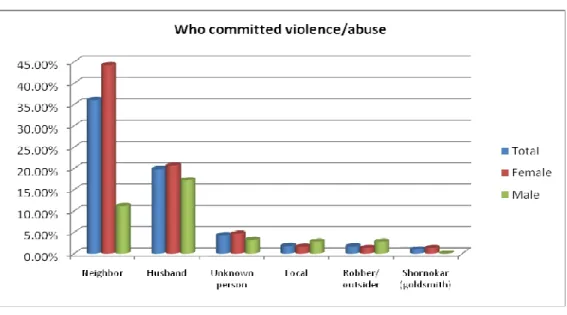The study was mostly qualitative, but a quantitative household survey was also conducted because there was no existing baseline data on the study population. This trend is also important in relation to the position of women in the family. But there was evidence in the study's findings that the legal system did not deal with such complaints.
General Objectives
Voices of the Burmese Rohingya Refugees: Everyday Politics of Survival in Refugee Camps in Bangladesh”. Given the objectives of the research and a focus on SGBV, we adopted a purposive sampling measure. However, the ratio of women to men varied a little at each site due to the availability of the respondents.
Key Findings
Sample characteristics: socio-economic profile
The dialect and language of the UMN respondents were sometimes difficult to understand, and therefore much time was spent on translation by field researchers. Another restriction was that outsiders at the temporary sites of Leda and Kutupalong were not allowed to stay beyond 4pm. Some of the key informants (BMC and CMC leaders) also fled into the Leda camp because they were afraid of being questioned by the security forces.
28.7% of respondents came to their current place of residence in the last 8 years. In Shamlapur, the age level was higher among the respondents, only 5% were in the same category as above (Table 7.2). Culturally, it is acceptable in Bangladesh for hijras to dance and sing whenever a new baby is born in a village or neighborhood.
In some areas it is also socially acceptable for them to take a handful of rice or vegetables from market vendors free of charge (Table 7.4). This may be the reason for the statistical dominance of the nuclear family type among UMNs. This is a general trend in the local population as well.19 This trend is also important in relation to the position of the woman in the family.
Although circumstances of poverty drive both women and men to work for a living, women's relative lack of assets compared to men makes them dependent in the power relations within the family (see figures below) and especially in negotiations leading to marriage.
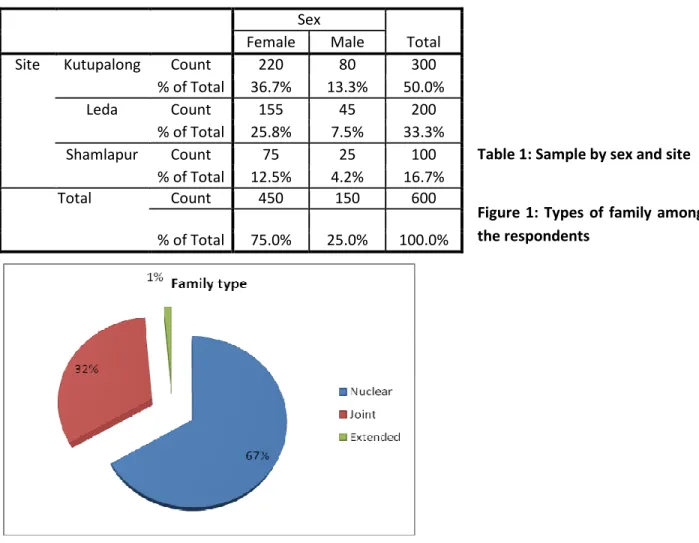
Attitudinal perception
SGBV
- Marital Status
- Reasons and processes that make women vulnerable to violence
- Violence: nature and frequency
- Support services
- Medical support services
- Justice Support System
Islamic marriage laws allow customary marriage practices to prevail and be socially accepted in the region. It was customary in the camp for a man to divorce a woman by saying "I divorce you" three times. In Leda, a slightly higher percentage of respondents (10.2%) said in the house compared to Kutupalong (6%) or Shamlapur (1.8%).
Since MSF staff were nearby, they came to her aid and took her to the hospital in the same jeep. Even at the hospital, they threatened the doctor and said they would rape Rowshan. The women faced harassment on their way to the toilets located near the official camp.
When asked which solution they prefer in case of violence, 23.7% of respondents said they prefer mediation to stay in the family, 68.8% said they don't know, 6.8% said they accept it with suffering (Table 41). NGO Forum supplies water to the camp at designated time in the morning and afternoon. Children were often seen to be in shock in the way they spoke or approached people.
Traditional leaders like the Majhi system also became members of the boards of directors. This will certainly have implications for the prevailing justice system operating in these places. The lack of social awareness of women's fundamental rights was quite evident in the region in general and in the UMN in particular.
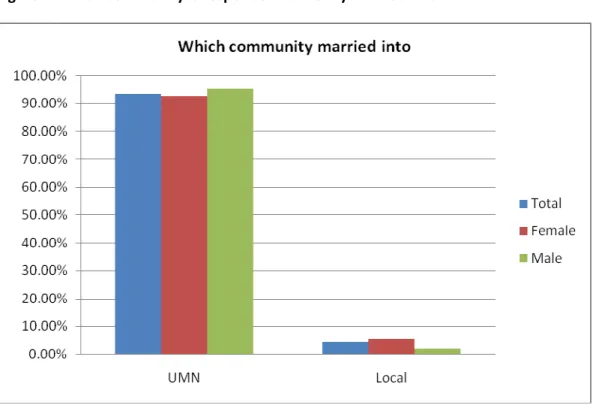
Child protection
Customary marriage practices in the region sanctified by religion, such as marriage by the Kazi and the presence of witnesses, did not prove that polygamy was useful if either of the aggrieved parties wanted to take legal action. The concept of violence itself seems to have been normalized in the region to the extent that certain types of violence, such as assault on women, kidnapping of beautiful girls, do not seem to have affected the general public except those directly affected. When asked if their children were subjected to violence, 79% said no while 10.3% said yes (Table 50).
The response to the question of whether their daughter was subject to violence in the in-laws' place revealed a conservative estimate, 27.3% said no, but 9.7% said yes (Table 58). Some of the children went to private schools in the neighborhood or neighboring villages run by the local Bangladeshi community through private donations, and sometimes through local NGOs, but it is not easy for them as these schools were expensive. Therefore, traces of both a need as well as practice of informal adoption were found in the region.
Also in the camps there were parents who were not completely unaware of their children's welfare and for whom protection of their children was instinctive. Despite the above humanitarian examples of which there were many in the area, it was found that the rate of child labor among the UMNs is generally high26 and this is understood in the context of vulnerability of the households. Child welfare must be seen as part of an overall protection strategy of UMNs.
Due to family insolvency, especially in families where the male earner has abandoned his wife and children, many have had to sell their work under difficult conditions.
Local context
- Human trafficking and drug abuse
- Setting up residency In terms of location of
- Relation with host community and intra-community relations
- Human Security Issues
- Political and power relationships in the locality
23% said they took the illegal route by sea/land and 1.7% said they took a legal route and went by air. Among those who said they were negatively affected by it, 6.7% said they could not find a trace of them, 6.2% said they were arrested on their way to Malaysia, 4.8%. Most of them were in Leda and Kutupalong (Table 66). 26.5% said it was their neighbors, followed by family members and community members (Table 67).
17.7% said they were not directly connected to the Yabba trade but were still negatively affected. They were connected to the sex trade and women trafficking in the hotels of Cox's Bazaar. 13.2% said Domdomia (a jetty located in Teknaf where people from Myanmar sometimes make their first stop near the densely forested banks of the river Naf), 10.7% said Teknaf and 7% said Cox's Bazaar.
Martin and Bandarban (Table 70). The majority appeared to have settled here 7 to 8 years ago (Table 71). When asked how their relationship with the host community was, 63.2% said friendly, 26% said conflicted, and 5.5% answered competitive (Table 76). In response to the question of what process can be adopted, 22.8% said they did not know, 16.5% said law and enforcement, while 15.7% said NGOs can help.
When asked if their security will be better in the future, 66% of respondents thought so, and 33.5% said no.
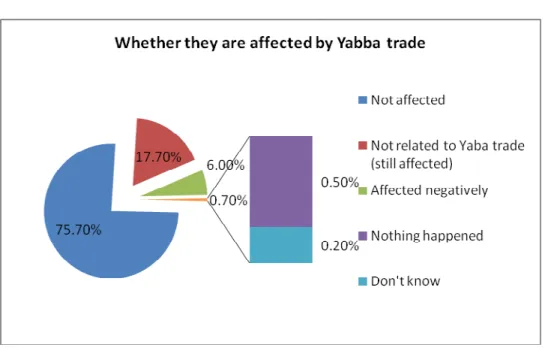
6 Conclusion and Recommendations
Programmatic components .1 Responses
Survivor groups can be formed from these women to help spread information and awareness among other women in the form of peer group consultations. Implementing partners may consider employing a lawyer to liaise with local law enforcement agencies to take up criminal cases such as rape and murder that occur on the sites and that can be tried in court. Address issues such as conflict over resource distribution in the sites and regularly monitor places where residents may be at risk, e.g.
Joint male and female forums can be formed where all these voices can be heard on the issue of SGBV. Local Union Parishad members police force and other officials must undergo training and exposure to some success story in the field of SGBV. Youth (Both boys and girls, separately) can be brought in as part of a study circle to address SGBV.
In light of government opposition to this idea, they may take the form of occupational therapy for victims of violence. Conflict transformation may be: Staff may need training in conflict transformation processes, although they may be working with sector-based needs such as water and sanitation. Some implementing partners such as ACF and MSF are already working in the provisional sites of embryonic SGBV programmes.
Organizations specialized in the application of the participatory method, particularly among displaced persons or refugees, can be contacted for assistance in training and capacity building of existing staff.
Advocacy and Campaign .1 Responses
- Approaches
- Collaborations
Children's education should also enable them to develop coping mechanisms in which to face the modern world and the dangers it entails. Sexual and reproductive health can be addressed as part of the existing curriculum for health issues n. Livelihood programs need to be developed as well as secure sources of income are needed to prevent SGBV.
In this way, the work will not be directly related to the marketing of the product, but it can take care of the needs of those living in the camps, e.g. Participatory processes such as participatory action research, dialogues can be used to help create proactive leadership among UMNs. Under the broader auspices of the Law and Order Committee, there is already a Committee for the Prevention of Violence against Women, which meets monthly to discuss and monitor the situation in the district.
Since UMNs are often involved in law and order situations, it would be good to have IOM partner NGOs sit in on these meetings as relevant stakeholders. Home-based work for women can be advocated and local NGOs can be involved. Individual means of advocacy and lobbying such as petitions, dialogues with relevant government offices can be addressed at the local and national level for specific issues.
BNWLA, (2016) Protection Assessment for Disadvantaged Undocumented Myanmar Nationals and Local People in Selected Areas of Cox's Bazaar District, Dhaka, Unpublished Report. Policies of Persecution: Ending Violent State Policies Against Rohingya Muslims in Myanmar, Retrieved from www.fortifyrights.org. The contribution of food aid to durable solutions in protracted refugee situations: its impact and role in Bangladesh, WFP and UNHCR UNHCR.
Statement by Volker Türk, UNHCR Assistant High Commissioner for Protection, at the Special Meeting on Irregular Migration in the Indian Ocean 29 May 2015 Bangkok, Thailand.
